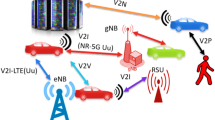Abstract
This article provides an overview about vehicle-to-everything communications in relation to the latest Long Term Evolution (LTE) standards. We describe the main vehicular services and give a brief review of vehicular communication systems over LTE for both infrastructure-to-vehicle communications over the broadcast/multicast LTE service and vehicle-to-vehicle communications over the LTE sidelink. Next, we analyze the performance of vehicular systems using link simulations for different vehicular channel models implemented on a LTE simulator called WM-SIMA. Finally, we draw some conclusions about the impact of using different modulation and coding scheme as well as the interference level on the overall performance.
















Similar content being viewed by others
Explore related subjects
Discover the latest articles, news and stories from top researchers in related subjects.Notes
TPEG is the transportation equivalent to JPEG protocol suite for images.
WM-SIMA simulator allows including any evolved node B (eNB) position. Those shown here are only for the sake of exemplification and do not represent a real deployment.
References
European Commission. (2010). Directive 2010/40/EU of the European Parliament and of the Council of 7 July 2010 on the framework for the deployment of intelligent transport systems in the field of road transport and for interfaces with other modes of transport.
Carreras, A., Delgado-Luque, I. M., Martín-Vega, F. J., Gómez, G., Aguayo-Torres, M. C., & Entrambasaguas, J. T. (2018). A system-level simulator for the downlink of LTE-A: Case of study–cell-offloading in HetNets. Wireless Personal Communications, 100(1), 177–191.
European Telecommunications Standards Institute (ETSI). (2019). Intelligent Transport System (ITS); Vehicular communications; Basic set of applications; Part 2: Specification of cooperative awareness basic service. ETSI EN 102.637 -2
European Telecommunications Standards Institute (ETSI). (2019). Intelligent Transport System (ITS); Vehicular communications; Basic set of applications; Part 3: Specifications of decentralized environmental notification basic service. ETSI EN 102.637-3.
European Telecommunications Standards Institute (ETSI). (2013). Intelligent Transport System (ITS); V2X Applications; Part 1 to 3. ETSI TS, 101, 539.
Society of Automotive Engineers (SAE). (2009). Dedicated short range communications (DSRC) message set dictionary. SAE J2735.
Institute of Electrical and Electronics Engineers (IEEE). (2016). IEEE standard for information technology–Telecommunications and information exchange between systems. Local and metropolitan area networks–Specific requirements—Part 11: Wireless LAN Medium Access Control (MAC) and Physical Layer (PHY) Specifications. IEEE Std 802.11-2016.
3rd Generation Partnership Project (3GPP). (2017). Technical Specification Group Radio Access Network; Evolved Universal Terrestrial Radio Access (E-UTRA); LTE physical layer; General description. 3GPP TS 36.201 (Release 14).
Molina-Masegosa, R., & Gozalvez, J. (2017). LTE-V for sidelink 5G V2X vehicular communications: A new 5G technology for short-range vehicle-to-everything communications. IEEE Vehicular Technology Magazine, 12(4), 30–39.
European Telecommunications Standards Institute (ETSI). (2016). Intelligent Transport System (ITS); Vehicular communications; Basic set of applications; Facilities layer protocols and communication requirements for infrastructure services. ETSI TS, 103.301.
CEN Technical Committee 278. (2018). Intelligent transport systems—DATEX II data exchange specifications for traffic management and information. https://www.datex2.eu/datex2/specifications.
Viavi Solutions. (2015). LTE evolved multimedia broadcast multicast services (eMBMS). https://www.viavisolutions.com/de-de/literature/lte-evolved-multimedia-broadcast-multicast-services-embms-white-paper-en.pdf (last retrieved July 23rd 2019).
3rd Generation Partnership Project (3GPP). (2019). Enhanced television services over 3GPP eMBMS (2017, last retrieved July 23rd). https://www.3gpp.org/images/PDF/EnTV_article_for_3GPP_Web_site_v8.pdf.
3rd Generation Partnership Project (3GPP). (2019). Evolved universal terrestrial radio access (E-UTRA); LTE physical layer; Architecture enhancements for V2X services. 3GPP TS 36.285 (Release 16).
Martín-Vega, F. J., Soret, B., Aguayo-Torres, M. C., Kovács, I. Z., & Gómez, G. (2018). Geolocation-based access for vehicular communications: Analysis and optimization via stochastic geometry. IEEE Transactions on Vehicular Technology, 67(4), 3069–3084.
Cortés, J. A., Aguayo-Torres, M. C., Cañete, F. J., Gómez, G., Martos-Naya, E., & Entrambasaguas, J. T. (2019). Vehicular channels: Characteristics, models and implications on communication systems design. Wireless Personal Communications, 106(1), 237–260.
3rd Generation Partnership Project (3GPP). (2018). Study on channel model for frequencies from 0.5 to 100 GHz. 3GPP TR 38.901 (Release 15).
Jakes, W. C. (1974). Microwave Mobile Communications. New York: Wiley.
Pop, M. F., & Beaulieu, N. C. (2001). Limitations of sum-of-sinusoids fading channel simulators. IEEE Transactions on Communications, 49(4), 699–708.
Karedal, J., Tufvesson, F., Czink, N., Paier, A., Dumard, C., Zemen, T., et al. (2009). A geometry-based stochastic MIMO model for vehicle-to-vehicle communications. IEEE Transactions on Wireless Communications, 8(7), 3646–3657.
3rd Generation Partnership Project (3GPP). (2019). Technical Specification Group Radio Access Network; Evolved Universal Terrestrial Radio Access (E-UTRA); Physical layer procedures. 3GPP TS 36.213 (Release 15).
Boban, M., Kousaridas, A., Manolakis, K., Eichinger, J., & Xu, W. (2018). Connected roads of the future: Use cases, requirements, and design considerations for vehicle-to-everything communications. IEEE Vehicular Technology Magazine, 13(3), 110–123.
Acknowledgements
This work has been supported by the Spanish Government (Ministerio de Economía y Competitividad) and FEDER under Grant TEC2016-80090-C2-1-R, by the Junta de Andalucia under Grants P18-RT-3175 and P18-TP-3587, by the Proyectos Singulares de Actuaciones de Transferencia en los CEI (Áreas RIS3), and by the Universidad de Málaga.
Author information
Authors and Affiliations
Corresponding author
Additional information
Publisher's Note
Springer Nature remains neutral with regard to jurisdictional claims in published maps and institutional affiliations.
Rights and permissions
About this article
Cite this article
Barranco, A.C., Gálvez, J.A.Y., Armijo, J.A. et al. Overview of LTE for Vehicular Communications. Wireless Pers Commun 113, 1471–1494 (2020). https://doi.org/10.1007/s11277-020-07246-w
Published:
Issue Date:
DOI: https://doi.org/10.1007/s11277-020-07246-w




